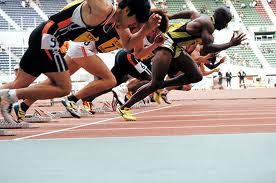Steeplechase events take place on a track combining several different skills into one event, including distance running, hurdling and long jumping.
Steeplechase sport began as a race between towns from one church steeple to another - with natural obstacles along the way. It entered the Olympics as a 3000-meter event in 1920. The steeplechase for women (3,000 meters long, but with lower barriers than for the men) in Olympic appeared for the first time in Beijing 2008.
The Steeplechase 3000-meter event includes 28 hurdle jumps and seven water jumps. The hurdles for men’s events are .914 meters high and .762 meters high for the women’s steeplechase. The jumps begin after the runners pass the finish line for the first time. There are five jumps in each of the final seven laps, with the water jump as the fourth. The hurdles are solid and cannot be knocked over, but the tops are five inches long so hurdlers can step on them, if necessary.
The hurdle at the water jump is 3.66 meters wide while the remaining hurdles are at least 3.94 meters wide, so more than one runner can clear a hurdle at the same time. The jumps are evenly distributed throughout the track. Each runner must go over or through the water pit and must jump each hurdle.
The current Olympic record in men's 3000 meter steeplechase is held by Kenyan athlete Julius Kariuki. His timing in the event in the 1988 Seoul Summer Games was 8:05.51 seconds.
Sport Ticket Exchange is guaranteed, fast and secure source to buy Sport Tickets especially Olympic Tickets. Olympic fans that have spare tickets and want to earn profit can Sell Olympic Tickets at Sport Ticket Exchange.
Olympic Athletics Tickets
Sport Ticket Exchange




















